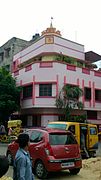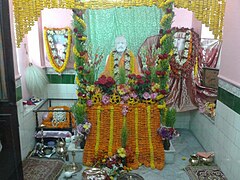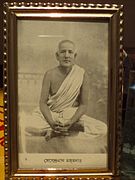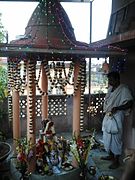Entally
Entally | |
|---|---|
Neighbourhood in Kolkata (Calcutta) | |
Entally |
Entally (also spelt Entali) is a neighbourhood of Central
History
The
Odia palanquin-bearers, poor Christians, Muslims, Chinese and other depressed communities such as
In those days, the Municipal Railway ran along the side of Lower Circular Road (renamed
In the nineteenth century many factories were set up in Entally because of the low cost of land. Many of them survive to this day.[1]
Entally,
In 1888, one of the 25 newly organized police section houses was located in Entally.[8]
Geography
Entally is spread over parts of Ward Nos. 54, 55 and 56 of Kolkata Municipal Corporation, partly under Entally police station and partly under Beniapukur police station. It is bounded by
Police district
Entally police station is part of the Eastern Suburban division of Kolkata Police.[10]
Ultadanga Women police station covers all police districts under the jurisdiction of the Eastern Suburban division i.e Beliaghata, Entally, Maniktala, Narkeldanga, Ultadanga, Tangra and Phoolbagan.[10]
Economics
Entally market is one of the old markets in Kolkata under Kolkata Municipal Corporation (KMC). Shops sell ready-made garments, vegetables, groceries, textiles, margarine, fish and fruits.[11] This market was once famously known for its dairy product shops that provided high quality dairy items such as paneer, ghee, yogurt, condensed milk, cheese and butter.
Culture
Mother Teresa arrived in Kolkata in 1928. While teaching in Loreto Convent at Entally, the slums beyond the school compound engaged her more and more. In 1948, when she secured permission to work fully with the poor and the sick, she established a home in an obscure house in Entally, with a nurse's training and a meager Rs. 5 in her pocket. Her activities spread out subsequently to other areas of Kolkata.[2]
Gope Lane Shiva Temple (Sridhar Jew Mandir) is the oldest Hindu temple of Entally established by local Ghosh community. It was a centre for social reforms and freedom fighting during British colonial rule. It was also the centre of movements for social justice and cultural development of the non-higher caste Hindus and minorities. Later such movements got recognised by government with the formation of the other backward classes (OBC) ensuring social justice. Prafulla Chandra Ghosh, the 1st chief minister of West Bengal during his tenure from 1947 to 1948 addressed several meetings in this place. He gave importance to educational and overall cultural development of non-upper caste Hindu's, depressed communities, Dalits and minorities. For uplifting backward classes Sir Jnan Chandra Ghosh suggested developing institution for technical education which was later realised by establishment of Central Calcutta Pyrotechnic in Entally. Pandit Pannalal Ghosh credited with popularizing the flute as a concert instrument in Hindustani classical music used to perform music concerts along with Padma Bhushan Pandit Jnan Prakash Ghosh and other distinguished musicians in Gope Lane.
Sri Sri Radha Mohan Jew temple house is situated in Panbagan Lane in Entally. Many cultural events, social gatherings and seasonal festivals are held here. It is considered to be first establishment in Calcutta to perform daily worship and bhajan of
Lay Disciple of Sri Ramakrishna, Debendra Nath Majumdar,
Education
Loreto Entally was founded as an orphanage in 1845 but it is no longer an orphanage in the strict sense, although orphans continue to be looked after. Loreto Kilkenny has been twinned with Loreto Entally.[16]
Transport
Road
Many buses ply along Acharya Jagadish Chandra Bose Road, Dr. Lal Mohan Bhattacharya Road and CIT Road in Entally. Lenin Sarani and Surendranath Banerjee Road (S.N. Banerjee Road) connect this locality to Esplanade.[17] Moulali is a 5 point junction in Entally connecting East Kolkata with Central Kolkata through Lenin Sarani, S N Banerjee Road and CIT Road (Sundari Mohan Avenue) and North Kolkata with South Kolkata through A J C Bose Road.
Train
Gallery
-
Moulali Dargah
-
St. Teresa of Avila Church, Moulali
References
- ^ ISBN 978-0-19-563696-3.
- ^ a b Mother Teresa, in Calcutta, the Living City, Vol. II, p. 81
- ^ "District Census Handbook Kolkata, Census of India 2011, Series 20, Part XII A" (PDF). Pages 6-10: The History. Directorate of Census Operations, West Bengal. Retrieved 20 February 2018.
- ^ Cotton, H.E.A., Calcutta Old and New, first published 1909/reprint 1980, pages 103-4 and 221, General Printers and Publishers Pvt. Ltd.
- ^ Nair, P.Thankappan, The Growth and Development of Old Calcutta, in Calcutta, the Living City, Vol. I, pp. 14-15, Edited by Sukanta Chaudhuri, Oxford University Press, 1995 edition.
- ^ Cotton, H.E.A., Calcutta Old and New, 1909/1980, p. 223, General Printers and Publishers Pvt. Ltd.
- ^ Bagchi, Amiya Kumar, Wealth and Work in Calcutta, 1860-1921, in Calcutta, the Living City, Vol. I, p. 213.
- ^ Nair, P.Thankappan, The Growth and Development of Old Calcutta, in Calcutta, the Living City, Vol. I, pp. 18-19, Edited by Sukanta Chaudhuri, Oxford University Press, 1995 edition.
- ^ Detail Maps of 141 Wards of Kolkata, D.R.Publication and Sales Concern, 66 College Street, Kolkata – 700073
- ^ a b "Kolkata Police". East Suburban Division. KP. Retrieved 5 March 2018.
- ^ "Entally Market". india9.com. Retrieved 22 January 2008.
- ^ "Archived copy". Archived from the original on 20 July 2011. Retrieved 23 July 2015.
{{cite web}}: CS1 maint: archived copy as title (link) - ^ Swami Brahmananda
- ^ "Devendra Mazumdar".
- ^ "Archived copy" (PDF). Archived from the original (PDF) on 12 December 2010. Retrieved 23 July 2015.
{{cite web}}: CS1 maint: archived copy as title (link) - ^ "Loreto Kilkenny twinned with Loreto Entally, India". 1977. loretokk.com. Archived from the original on 18 November 2007. Retrieved 22 January 2008.
- ^ Google maps
External links
![]() Kolkata/South travel guide from Wikivoyage
Kolkata/South travel guide from Wikivoyage









